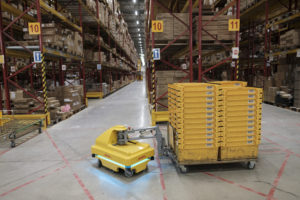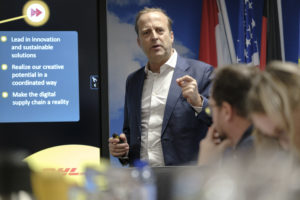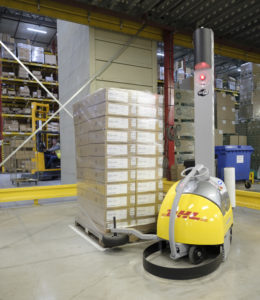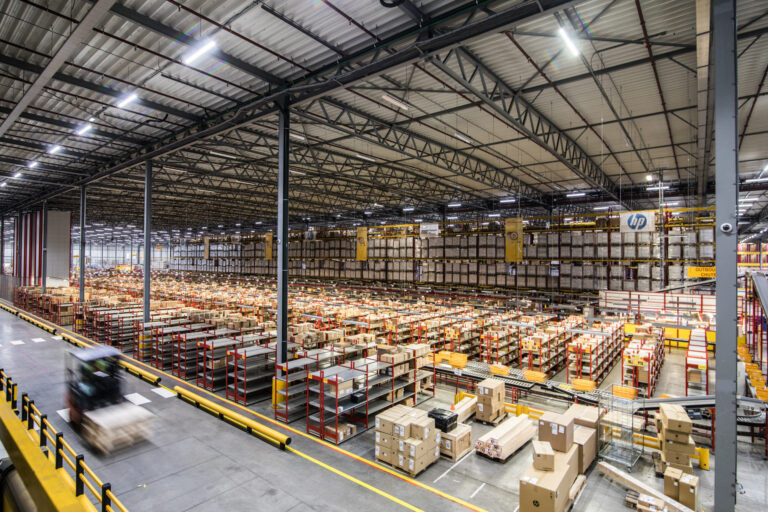The logistics industry is on the ‘brink of a major disruptive wave’ driven by digitalisation and innovation, that will transform the way services are delivered in the sector according to the largest supplier of third-party logistics in the world.
DHL Supply Chain laid out its ambitions to be a “leader” in digitalisation and innovation – its Strategy 2025 – that will see it develop products in partnership with start-up’s around the world, that can be productised and delivered into live warehousing environments. It has already identified 12 different technologies where products can, and are, operate in a live warehousing environment.
Markus Voss, chief information officer and chief operating officer at DHL Supply Chain, said:“When you look at supply chain we are on the brink of major disruption. If you compare us to the media sector nobody is buying CDs anymore. We are consuming media in a totally different way. We are seeing the disruption of the logistics industry and it is so exciting to shape what the future of the sector will be.
 Voss said that DHL Supply Chain was “constantly identifying products as there are many, many start-ups investing in logistics”. He said that private equity invested in logistics has quadrupled in the “past couple of years” and it was a case of “confirming the potentials”.
Voss said that DHL Supply Chain was “constantly identifying products as there are many, many start-ups investing in logistics”. He said that private equity invested in logistics has quadrupled in the “past couple of years” and it was a case of “confirming the potentials”.
“Where this industry has struggled is that innovation is not productised and rolled out in high quantities and we have worked very hard to change that whole paradigm,” explained Voss. “We have invested in finding productisation. Not all technologies are equally relevant to all sites. We have looked at the characteristics of all 2,000 of our sites and identified where technologies will fit. That means disruptive technologies are not hit and miss, we identify where the right technology goes to the right sites.”
Voss explained that DHL Supply Chain had a pipeline of 2,000 initiatives of technologies it believed could be rolled out with technology that is proven and can drive benefits over a very short period of time. He cited a roll-out of assisted picking robots on piece picking operations as an example of where a new technology could take away a lot of physical work from people.
However, Voss said, it would be, “indoor robotic transport… that will have the biggest impact for us”.
“Moving goods with a forklift around a warehouse is one of the most prevalent tasks that is happening. So there is huge potential for us to replace forklifts and any type of movement with something that drives on its own. This makes for a much safer environment as well.

Oscar de Bok, chief executive of DHL Supply Chain, said that the 3PL was “not just the leading contract logistics provider in the world” but a “leader in digitalisation and innovation” as well.
“As we continue to grow alongside the market, our customer-focused approach enables us to transform innovative ideas into scalable and commercially viable products that we can roll-out across the regions,” de Bok said.
He explained that the biggest difference between its Strategy 2020 and its Strategy 2025 is top-line growth at DHL Supply Chain.
“In our strategy 2020 we improved drastically our bottom-line,” he said. “Not only are we twice the size of our nearest competitor, we also earn twice that of our next competitor. Now we want to ensure we maintain that level and accelerate our top line. To do that we need to achieve net growth: we keep our existing customers, we grow with them and win new business. For that customer perception is so important.
“Having one operation with some interesting processes is not innovation. Innovation is having a great idea and implementing it on a large scale throughout the globe. Then you are truly innovative in the industry and that is the ambition you have at the moment.
“We are not going to wait for customers to tell us what is happening tomorrow, we will tell them what tomorrow will be, and what will be good for their processes,” he said.

DHL has identified 12 areas where it sees opportunities for new technology to be scale widely:
- Goods-to-person robots (seven projects deployed worldwide)
- Indoor robotic transport (27 projects deployed worldwide)
- Assisted picking robots (10 projects deployed worldwide)
- Robotic arms (20 projects deployed worldwide)
- Narrow aisle robots (three projects deployed worldwide)
- DHL Resource planning (32 projects deployed worldwide)
- Wearable devices (220 projects deployed worldwide)
- Inventory management robots (13 projects deployed worldwide)
- Robotics process automation (122 projects deployed worldwide)
- Design and simulation (16 projects deployed worldwide)
- Cleaning robots (17 projects deployed worldwide)
- Wrapping robots (79 projects deployed worldwide)
“Not only have we identified the areas but we have identified the specific solutions,” said de Bok. “For each continent we have identified specific suppliers, and on that basis we link that with the profiles of all our sites and where we can roll them out. We are very structured on how we are rolling out our innovation agenda, where our customers can benefit from it and where we can grow with it.”







